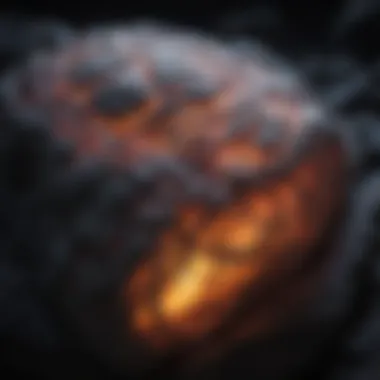Unveiling the Significance of UV Lights in Rock and Fossil Collecting


Rock and Fossil Identification
In the world of rock and fossil collecting, having a keen eye for detail is essential. When it comes to identifying different types of rocks and fossils, collectors must pay close attention to the distinctive characteristics that set each specimen apart. From the intricate patterns of minerals to the unique shapes and textures, being able to discern these features is crucial in determining the origin and composition of the rocks and fossils. To aid in this process, collectors utilize a variety of tools such as magnifying glasses, black lights, and UV lights to reveal hidden fluorescent properties that can provide valuable insights into the nature of the specimens.
Introduction
In the realm of rock and fossil collecting, the role of UV lights emerges as a critical element that elevates the entire experience. These lights serve as essential tools in unveiling the hidden beauty and intricate details of geological specimens that are not visible to the naked eye under regular conditions. The utilization of UV lights opens up a new dimension in the exploration and appreciation of rocks and fossils, providing collectors with a deeper understanding and greater insight into the geological wonders they encounter. Through this article, we will delve into the various facets of UV lights and elucidate their importance in enhancing the rock and fossil collecting journey.
Understanding UV Lights
The Science Behind UV Lights
Delving into the science behind UV lights unveils the fascinating phenomenon of fluorescence exhibited by certain minerals when exposed to ultraviolet radiation. This property allows collectors to distinguish between different minerals based on their fluorescence characteristics, aiding in the identification process of geological specimens. The emission of visible light by minerals under UV illumination enables collectors to discern subtle variations in composition and make informed decisions about the specimens they encounter. Despite the benefits of fluorescence in mineral identification, some minerals may not exhibit this property, posing a challenge in certain cases. Understanding the science behind UV lights provides collectors with a valuable insight into the chemical composition and unique properties of minerals, enhancing their ability to recognize and appreciate geological specimens.
Types of UV Lights
When considering the types of UV lights available for rock and fossil collectors, two primary categories stand out: long-wave UV (UVA) and short-wave UV (UVB) lights. Long-wave UV lights are ideal for general fluorescence observation, as they are less harmful to both collectors and geological specimens. On the other hand, short-wave UV lights are more intense and capable of revealing fluorescence patterns in a more vivid manner, but they come with potential risks if not used with caution. Selecting the appropriate type of UV light depends on the specific requirements of the rock or fossil examination, balancing between optimal fluorescence display and ensuring the preservation of delicate specimens. By understanding the distinctions between long-wave and short-wave UV lights, collectors can make informed decisions that enhance their overall rock and fossil collecting experience.
Importance of UV Lights in Rock and Fossil Collecting
In the realm of rock and fossil collecting, the importance of UV lights cannot be overstated. These powerful tools play a pivotal role in enhancing the overall experience for enthusiasts and professionals alike. From unveiling hidden details to preserving and documenting geological specimens, UV lights offer a myriad of benefits that significantly elevate the collecting process. By showcasing the beauty of rocks and fossils under ultraviolet illumination, collectors gain valuable insights and a deeper appreciation for the natural world they are exploring.
Identification and Examination
Revealing hidden details
One of the key functions of UV lights in rock and fossil collecting is the ability to reveal hidden details that may not be visible to the naked eye. By illuminating specimens with UV light, collectors can uncover intricate patterns, colors, and textures that are otherwise concealed. This process not only enhances the aesthetic appeal of the rocks and fossils but also aids in the identification of specific minerals or materials present. The unique characteristic of revealing hidden details through UV light is its ability to highlight fluorescence, making certain features stand out vividly.


Detecting alterations and enhancements
Another crucial aspect of UV lights is their role in detecting alterations and enhancements on geological samples. Whether it's distinguishing between natural formations and man-made modifications or identifying the presence of coatings or treatments, UV lights provide valuable insights into the history and condition of a specimen. The key characteristic of this function lies in its ability to differentiate between authentic features and external changes, helping collectors make informed decisions about the specimens they encounter.
Preservation and Documentation
In the realm of preservation and documentation, UV lights offer indispensable benefits for rock and fossil collectors. By using UV light to prevent deterioration, enthusiasts can prolong the lifespan of their specimens by identifying potential areas of weakness or vulnerability. Additionally, creating a visual record through UV light enhances the documentation process by capturing details that may be imperceptible under normal lighting conditions. This meticulous approach ensures that the beauty and integrity of geological specimens are preserved for future generations to appreciate.
Preventing deterioration
The proactive approach of using UV light to prevent deterioration in rocks and fossils is a game-changer for collectors aiming to maintain the quality and stability of their specimens. By highlighting areas that are susceptible to damage or degradation, UV lights empower collectors to take preventive measures that safeguard the longevity of their valuable collections. The unique feature of UV lights in preventing deterioration is their ability to reveal hidden patterns of wear and stress, allowing collectors to address issues before they escalate.
Creating a visual record
Creating a visual record of rocks and fossils through UV light not only serves as a documentation tool but also enhances the scientific and aesthetic value of the specimens. By capturing details that may go unnoticed under regular light, collectors can build a comprehensive archive of their findings, showcasing the intricate beauty and unique characteristics of each specimen. The advantage of this approach lies in its ability to capture nuances and subtleties that contribute to a more thorough understanding and appreciation of geological formations.
Aesthetic Enhancement
Beyond the practical applications, UV lights also offer a significant avenue for aesthetic enhancement in rock and fossil collecting. By displaying fluorescence in certain minerals or materials, collectors can create visually stunning displays that highlight the natural beauty and diversity of geological specimens. Additionally, highlighting unique features through UV light adds a layer of intrigue and sophistication to collections, elevating their appeal and educational value.
Displaying fluorescence
The art of exhibiting fluorescence in rocks and fossils using UV light transforms ordinary specimens into mesmerizing displays of color and light. This unique characteristic draws attention to specific minerals or compounds that exhibit fluorescence under ultraviolet illumination, unveiling hidden patterns and details that add a magical quality to the collection. The advantage of displaying fluorescence lies in its ability to showcase the interactive nature of light and minerals, creating a captivating visual experience for collectors and observers alike.
Highlighting unique features
By utilizing UV light to highlight unique features in geological specimens, collectors can accentuate distinctive characteristics that set certain rocks and fossils apart. Whether it's a rare mineral formation, fossil imprint, or geological anomaly, UV light can be employed to emphasize these features and amplify their visual impact. The advantage of highlighting unique features through UV light is its ability to bring attention to the intricacies and diversity of the natural world, fostering a deeper connection and appreciation for the wonders of geology.


Choosing the Right UV Light
In the realm of rock and fossil collecting, selecting the appropriate UV light is akin to choosing the perfect tool kit for an archaeologist. The significance of this decision cannot be understated, as the right UV light can unveil the hidden details, mysteries, and wonders concealed within geological specimens with unparalleled clarity and precision. Rock and fossil collectors rely on UV lights not only for identification and examination but also for preserving the authenticity and integrity of their precious finds. Thus, understanding the key elements and considerations in choosing the right UV light is paramount in elevating the collecting experience to new heights.
Factors to Consider
Wavelength Range
Delving into the intricacies of UV lights, the wavelength range emerges as a pivotal factor dictating the effectiveness of the illumination process. The wavelength range determines the specific spectrum of ultraviolet light emitted by the device, influencing how different minerals, compounds, and elements fluoresce under its glow. A crucial characteristic of the wavelength range is its ability to cater to diverse geological specimens, ranging from rocks rich in phosphorescent minerals to fossils embedded in ancient sediments. The versatility offered by a broad wavelength range ensures comprehensive coverage and accurate depiction of fluoresced features, making it a sought-after choice for collectors seeking precision and flexibility. While a wider wavelength range provides a more holistic view of the specimen, it may also result in a higher price point and increased power consumption, considerations that collectors must weigh against the benefits of enhanced visibility and clarity.
Portability and Durability
Equally essential in the selection process is the aspect of portability and durability, as collectors often traverse rugged terrains and navigate challenging environments in pursuit of geological treasures. A UV light that combines portability with durability becomes a reliable companion throughout these expeditions, offering a compact and sturdy design that can withstand the rigors of outdoor settings. The key characteristic of portability ensures that collectors can easily transport the device without compromising on functionality or performance, enabling them to conduct on-site examinations efficiently. Moreover, durability plays a crucial role in safeguarding the longevity of the UV light, ensuring sustained functionality even in adverse conditions. While lightweight and resilient materials enhance the overall user experience, collectors must also consider the trade-offs between portability and durability, striking a balance that aligns with their collecting needs and preferences.
Budget Constraints
Addressing the financial aspect of acquiring a UV light, budget constraints emerge as a pragmatic consideration influencing the purchase decision. Collectors must evaluate their budgetary limitations against the features, specifications, and quality offered by different UV lights to make an informed choice that optimizes value and performance. The key characteristic of budget constraints highlights the importance of striking a cost-effective balance between affordability and functionality, ensuring that collectors secure a UV light that meets their essential requirements without exceeding their financial boundaries. While budget-friendly options may offer basic functionalities for beginners or hobbyists, investing in a higher-priced UV light could unlock advanced features and precision for seasoned collectors seeking unparalleled accuracy and performance. Collectors are advised to conduct thorough research, compare prices, and prioritize essential features based on their collecting aspirations and long-term goals for a fulfilling and enriching experience.
Tips for Using UV Lights Effectively
When it comes to rock and fossil collecting, using UV lights effectively can elevate the entire experience to a new level of discovery and appreciation. Understanding the nuances of how UV lights work and incorporating best practices can make a significant difference in your collecting endeavors. By following some key tips, you can maximize the benefits of UV lights in this fascinating hobby.
Best Practices
Conducting Examinations in a Dark Room
One crucial aspect of using UV lights effectively is conducting examinations in a dark room. This practice enhances the fluorescence of rocks and fossils under UV light, making it easier to detect subtle details that might otherwise go unnoticed. The absence of ambient light allows the UV illumination to stand out, revealing hidden features and unique characteristics of geological specimens with clarity. Conducting examinations in a dark room is essential for capturing the full beauty and intricacies of the fluorescence displayed by rocks and fossils.


Using UV Light Filters
Another key element to consider when using UV lights effectively is employing UV light filters. These filters help to fine-tune the wavelength of UV light, enhancing the visibility of specific fluorescent features in rocks and fossils. By using UV light filters, collectors can isolate certain wavelengths to unveil distinct fluorescence patterns and color variations in geological specimens. The precision offered by UV light filters enables collectors to focus on particular details, providing a more nuanced examination of rocks and fossils under UV illumination.
Safety Precautions
In the realm of rock and fossil collecting, prioritizing safety precautions is paramount to ensure a fulfilling and secure experience. Understanding the potential risks associated with UV light exposure is crucial for enthusiasts engaging in this practice. By implementing specific safety measures, collectors can safeguard their well-being while exploring the fascinating world of geological specimens under UV illumination.
Protecting Your Eyes and Skin
Wearing UV-Resistant Goggles
When it comes to safeguarding your vision during rock and fossil examination under UV light, wearing UV-resistant goggles emerges as a key element in ensuring eye protection. These specialized goggles are designed to filter out harmful UV rays, preventing potential eye damage and maintaining ocular health. Their distinctive feature lies in their ability to block specific wavelengths of light, offering enhanced clarity and protection for collectors operating in UV-rich environments. The advantages of UV-resistant goggles in this context are multifaceted, ranging from reducing the risk of eye strain to guarding against potential long-term UV-induced eye conditions. While UV-resistant goggles are a popular choice among rock and fossil collectors, it is imperative to note that improper usage or substandard quality may compromise their effectiveness, underscoring the importance of investing in high-quality protective eyewear.
Applying Sunscreen
In the realm of rock and fossil collecting, overlooking the significance of skin protection can have detrimental effects on collectors exposed to UV light intensively. Applying sunscreen serves as a vital aspect of safeguarding one's skin from harmful UV rays, minimizing the risk of sunburns and long-term skin damage. The key characteristic of sunscreen lies in its ability to create a protective barrier against UV radiation, shielding the skin from potential harm. Its popularity stems from its accessibility and ease of application, making it a feasible choice for collectors venturing into UV-lit environments. While sunscreen offers undeniable advantages in protecting the skin, collectors should be mindful of potential disadvantages such as the need for reapplied application in prolonged sessions or under intense UV exposure. By integrating sunscreen application into their safety regimen, rock and fossil enthusiasts can effectively mitigate the risks associated with UV light exposure, promoting a safe and enjoyable collecting experience.
Conclusion
Embracing the Benefits of UV Lights
Enhancing your collecting experience
The process of enhancing your collecting experience through UV lights presents a myriad of advantages that redefine traditional rock and fossil examination techniques. By immersing specimens in UV light, collectors can unveil intricate fluorescent patterns and previously imperceptible features, adding a layer of depth and intrigue to their discoveries. This unique characteristic of enhancing the collecting experience using UV lights fosters a deeper connection with geological specimens, offering a novel perspective that transcends conventional viewing methods.
Moreover, the utilization of UV lights not only reveals hidden details but also enhances the aesthetic appeal of rocks and fossils, turning an ordinary collection into a visually captivating display. The ability to discern alterations and enhancements that are otherwise invisible to the naked eye enriches the overall experience and sets a new standard for collectors seeking a more immersive journey in the world of geology.
Unveiling the hidden beauty of geological specimens
Unveiling the hidden beauty of geological specimens through UV illumination brings to light a fascinating dimension of rocks and fossils that remains obscured under normal lighting conditions. The key characteristic of this process lies in its ability to expose the mesmerizing fluorescence that resides within these geological treasures, transforming mundane specimens into vibrant showcases of natural artistry.
By showcasing the fluorescence emitted by minerals under UV light, collectors gain a deeper understanding of the composition and history of each specimen, unveiling a hidden world teeming with intricate details and unexpected surprises. This unique feature of UV lights provides a gateway to unlocking the mysteries concealed within rocks and fossils, offering enthusiasts an unparalleled opportunity to appreciate the true beauty and complexity of the Earth's geological heritage.







